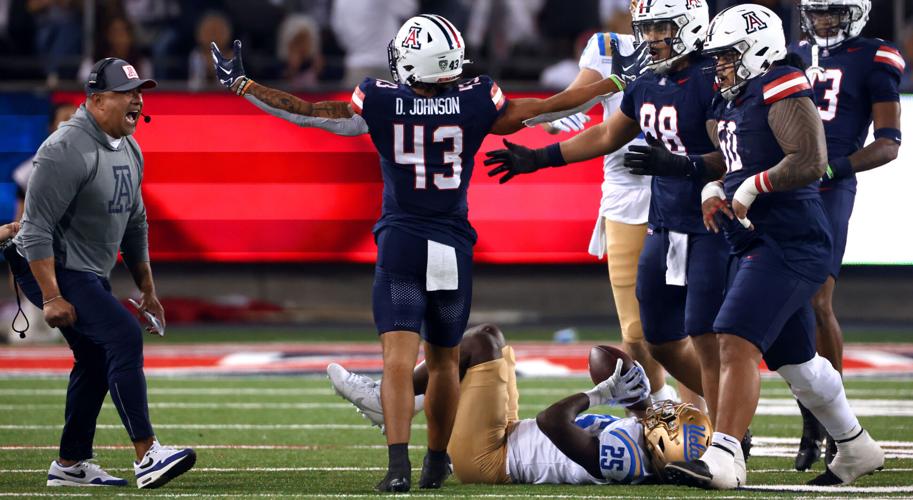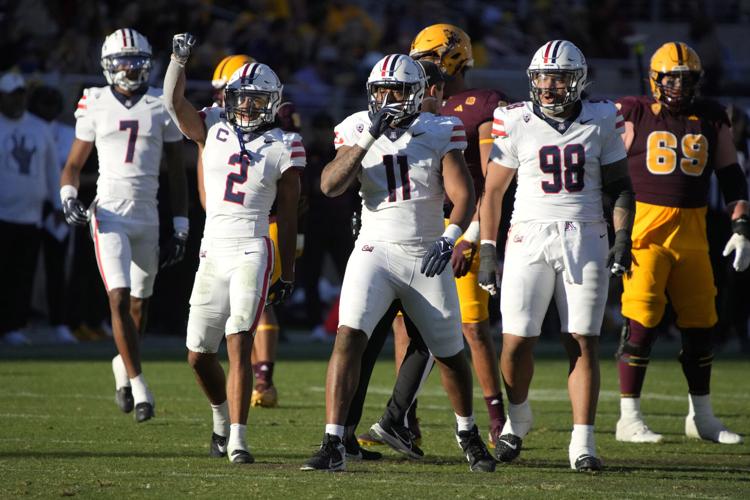Arizona’s rise in Year 3 under Jedd Fisch has been remarkable and well-documented. We could cite all sorts of numbers that illustrate the Wildcats’ improvement across the board.
But the story of the season — the biggest change from a year ago — is Arizona’s defense.
Yes, the Wildcats’ offense has operated more efficiently since Noah Fifita became the starting quarterback. But the UA defense has undergone a transformation that’s exceeded anyone’s reasonable expectations.

How that happened will be the subject of the final regular-season “Cats Stats” of 2023. We’ll return for more statistical analysis come bowl time.
Before we get into the specifics of Arizona’s defensive resurrection, let’s lay out the basics. The Wildcats made massive jumps in the three areas that typically define defensive performance: points allowed, yards allowed per game and yards allowed per play.
Arizona yielded 20.8 points per game during the regular season, down from 36.5 last year. It’s the first time the Wildcats have been under 30 since 2014 (28.2) and the first time they’ve been under 25 since ’13 (24.2).

Arizona's Tyler Manoa (92), left, and Dalton Johnson (43) close down Washington running back Dillon Johnson (7) in the fourth quarter of the teams' Pac-12 matchup on Sept. 30 at Arizona Stadium.
The Wildcats allowed 340.9 yards per game, down from 467.7 last season. That’s their lowest figure since 2010 — when it was 340.8 — and marks just the second time in the past 13 seasons that they’ve been below 400.
As you’d expect, Arizona enjoyed a similar drop in yards allowed per play. That number dipped from 6.59 to 5.27. It’s the Wildcats’ best mark since 2013 (5.26).
Anytime UA defensive coordinator Johnny Nansen is asked to explain his group’s improvement, he cites two factions: players and staff.
There’s no question that Arizona upgraded its personnel on the defensive line via the transfer portal, adding the likes of Tyler Manoa, Bill Norton and Taylor Upshaw, among others. Returning underclassmen such as Jacob Manu, Tacario Davis, Dalton Johnson, Gunner Maldonado and Ephesians Prysock also stepped up their games.
Adding Duane Akina to the staff has been an unquantifiable X-factor. Continuity played a huge role as well; Nansen is the first Arizona DC to coach the team for two full, consecutive seasons since Marcel Yates in 2017 and ’18.

Arizona defensive lineman Bill Norton (45) holds the turnover sword and the punctured fruit of three ASU turnovers in the final few minutes of the Wildcats’ 59-23 win over the Sun Devils in the 97th Territorial Cup matchup in Tempe last year.
But we’re all about the numbers here, and there are three stats that Nansen values most: run defense, limiting big plays and takeaways.
The Wildcats made huge strides in two of those three areas. They improved as a defense without a torrent of turnovers.
Arizona had 13 takeaways during the regular season — three fewer than last year. That number ticked up late in the season — five in the final two games vs. Utah and ASU — but, for the most part, the Wildcats didn’t rely on turnovers. There was nothing fluky about Arizona’s defensive surge.
A literal surge up front provided the foundation. The Wildcats disrupted and stymied opponents’ rushing attacks to a degree not seen around here since before many of the current players were born.
Arizona has allowed 111.3 rushing yards per game — nearly 100 fewer than last season (209.1). The Wildcats haven’t had a run defense this stifling since 2000 (88.5). The last time they finished under 120 yards was 2006 (119.7).
UA opponents averaged 3.44 yards per rush during the regular season — more than 2 yards less than last year’s 5.59. It’s the first time Arizona has limited the opposition to under 4 yards since 2010 (3.56).

Arizona's Ephesians Prysock (7), Treydan Stukes (2), Taylor Upshaw (11) and Tiaoalii Savea (98) celebrate in the second half of UA's win over ASU. There will be a different vibe and greater expectations for the Wildcats in 2024 after their 2023 success.
Nansen’s second pillar — limiting explosive plays — has been one of the biggest contributing factors.
In 2022, Arizona allowed 17 runs of 20-plus yards, including 10 of 30-plus and four of 40-plus. In 2023, those numbers plummeted to nine, two and one. (All explosive-play stats are courtesy of CFBStats.com.)
Overall (including pass plays), the Wildcats have allowed just four fewer plays of 20-plus yards – 53 vs. 57 a year ago. But they’ve limited those gains in a major way. Opponents have only 16 plays of 30-plus yards, down from 30 last season, and six plays of 40-plus, down from 14.
In short, aside from turnovers — which are, to some extent, a product of luck — the UA defense has executed Nansen’s check list to a tee.
Here are some other areas where the defense has made a sizable jump:
• Red zone. Absolutely seismic improvement here. Arizona allowed touchdowns on 78.95% of opponents’ trips to the red zone last season, second worst in the country. The Wildcats have lowered that number to 55.32%, tied for 42nd nationally.
• Third downs. Opponents have converted 40.99% of their third-down opportunities – down from 47.76% in 2022.
• Completion percentage. The Wildcats improved in this stat by almost 10 percentage points, limiting foes to a 59.8% completion rate, down from 69.7% in 2022.
• Pass rush. Arizona has almost doubled its sack total, going from 16 to 31. Upshaw’s 8.5 are the most by a Wildcat since Kylan Wilborn had seven in 2017. The UA also had 53 more QB pressures, going from 156 to 209, according to Pro Football Focus.
• Missed tackles. Huge reduction here, going from 152 to 113, per PFF. Correspondingly, Arizona allowed 338 fewer yards after the catch (1,362 vs. 1,700).
Arizona head coach Jedd Fisch held a news conference this week and discussed the Wildcats ending the regular season 9-3, bowl game prep, coaching contracts and increasing the salary pool, transfer portal and potential bowl opt-outs, among other topics. Video by Justin Spears / Arizona Daily Star









